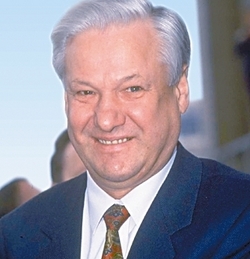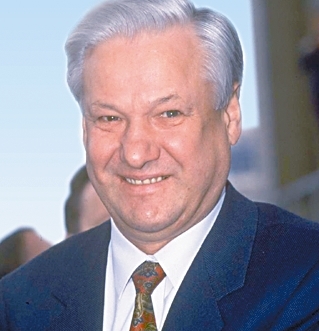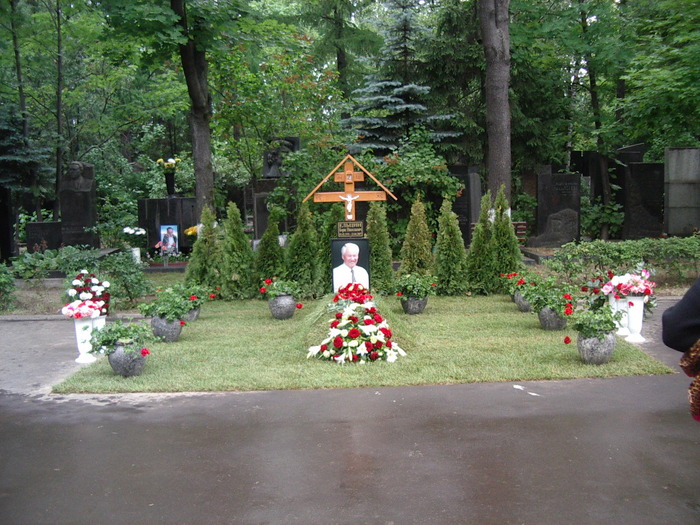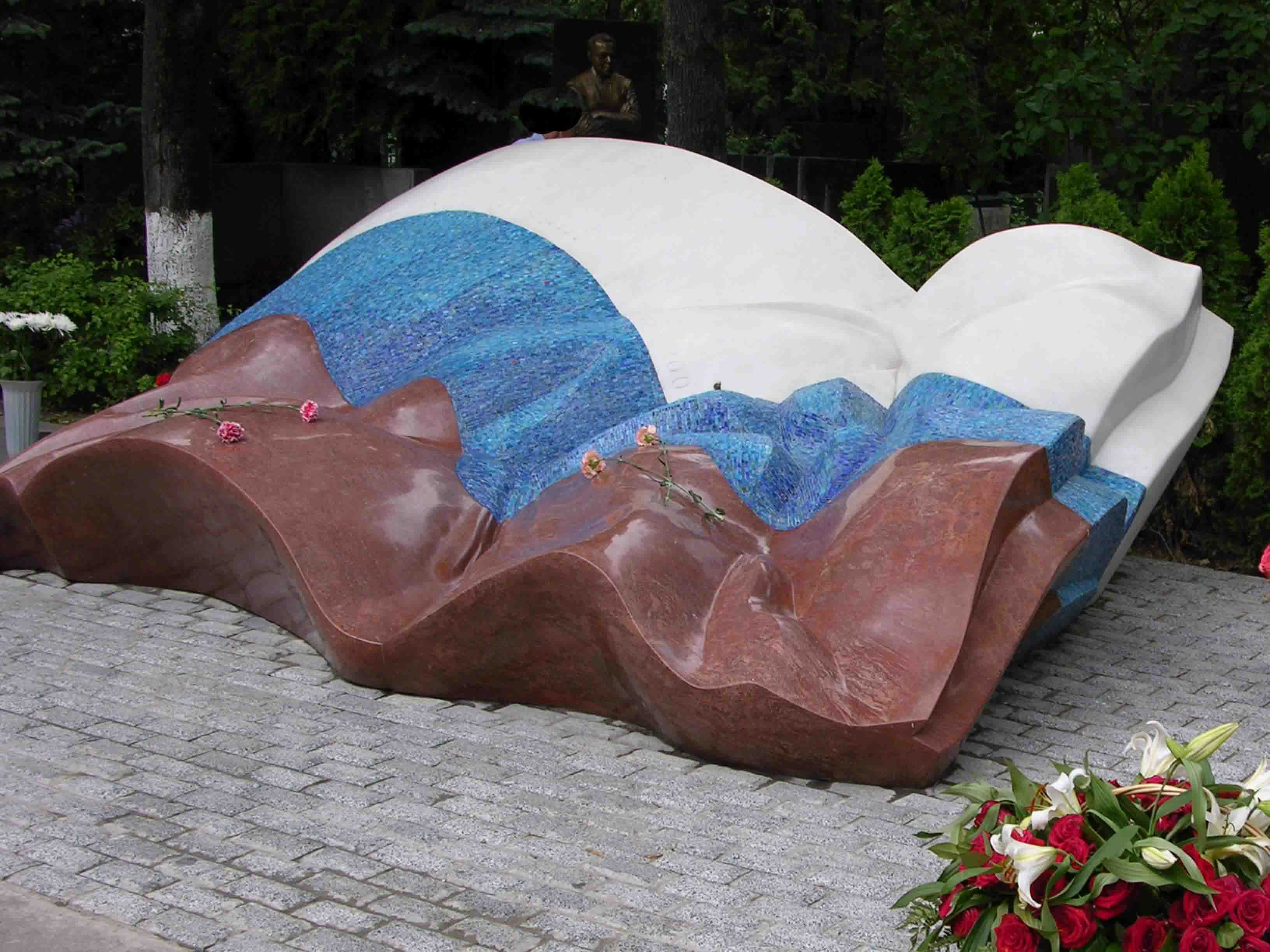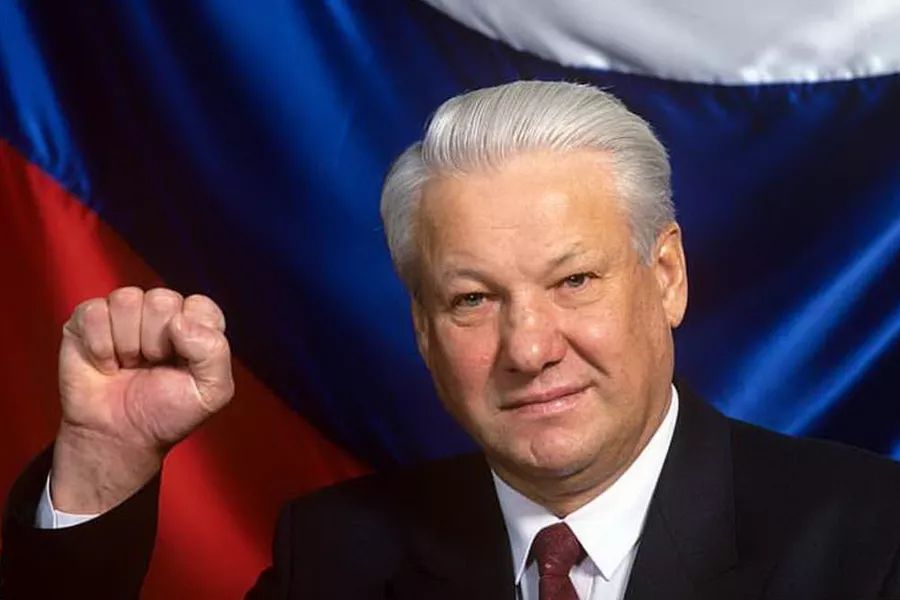Russian President. He is best remembered in the west for his standing on a Soviet tank in August 1991 to personally stop an attempted coup of the Soviet government by pro-communist military hardliners. He was the first freely elected President of Russian Federation, and helped Russia move in transition from dictatorship and a communist economy towards democracy and a capitalistic economy. He was born Boris Nikolayevich Yeltsin into a peasant family in the Sverdlovsk region of the USSR. As a young teenager during World War II, he and a group of mischievous kids sneaked into a Red Army ammunition storage dump, stealing military ammunition. While disassembling a hand grenade, the fuse exploded in his hand, blowing off his thumb and index finger and disabling his hand permanently. In later years, the press would make certain that most photos of Yeltsin did not show his missing fingers. Educated as an engineer, he married a fellow student, Naina Girina, and in 1961, he joined the Communist Party after working briefly in construction. In 1969, he became a full time party official, and in 1976, was named the regional party boss. In 1985, Soviet Premier Mikhail Gorbachev brought him to Moscow, to help with his reforms. After a fallout with Gorbachev in 1987, he was dismissed from his government post, but in the first true election in 1989, won a seat in Parliament, and shortly afterwards, he quit the Communist Party. In August 1991, as the communist world crumbled, Soviet hardliners attempted a coup against the Soviet government, sending tanks to occupy the Kremlin and other governmental buildings. As President of the Soviet Congress, Yeltsin personally led the people in a counter-coup, defending the Kremlin leadership of Mikhail Gorbachev in breaking up the Communist government. In December 1991, Yeltsin pushed through the legislation that officially ended the 70+ year Soviet rule. Despite a reform minded government and movement towards democracy, Yeltsin was also quick to use military force when he thought necessary. In October 1993, he used troops to remove hard-line Soviet supporters from the Russian parliament building that they had occupied. In December 1994, Yeltsin began a two-year war against separatists in the republic of Chechnya, resulting in the deaths of more than 10,000 people. During his early years in charge of the disintegrating Soviet Union, Yeltsin introduced the basic principles of democracy, such as guaranteeing the right to free speech, ownership of private property, the selling of nationalized (state-owned) property, establishing political parties, multiparty elections, and opening the borders to trade and travel. He was also open about his personal life, allowing the average Russian to see how he lived. Economic reforms played havoc with the economy, impoverishing millions of retired citizens whose guaranteed income from the government was often not paid out, and in 1998, the economy suffered a deep recession. This fueled a resurgence of communist elected deputies in the Russian Parliament, who attempted to impeach Yeltsin in May 1999. In foreign affairs, he oversaw the decline of Russia from superpower status, yet he would argue with the West over expansion of NATO. Passing control to his hand picked successor, Vladimir Putin, Yeltsin moved into retirement, suffering later from health problems. He reportedly died of heart problems at the age of 76.
Russian President. He is best remembered in the west for his standing on a Soviet tank in August 1991 to personally stop an attempted coup of the Soviet government by pro-communist military hardliners. He was the first freely elected President of Russian Federation, and helped Russia move in transition from dictatorship and a communist economy towards democracy and a capitalistic economy. He was born Boris Nikolayevich Yeltsin into a peasant family in the Sverdlovsk region of the USSR. As a young teenager during World War II, he and a group of mischievous kids sneaked into a Red Army ammunition storage dump, stealing military ammunition. While disassembling a hand grenade, the fuse exploded in his hand, blowing off his thumb and index finger and disabling his hand permanently. In later years, the press would make certain that most photos of Yeltsin did not show his missing fingers. Educated as an engineer, he married a fellow student, Naina Girina, and in 1961, he joined the Communist Party after working briefly in construction. In 1969, he became a full time party official, and in 1976, was named the regional party boss. In 1985, Soviet Premier Mikhail Gorbachev brought him to Moscow, to help with his reforms. After a fallout with Gorbachev in 1987, he was dismissed from his government post, but in the first true election in 1989, won a seat in Parliament, and shortly afterwards, he quit the Communist Party. In August 1991, as the communist world crumbled, Soviet hardliners attempted a coup against the Soviet government, sending tanks to occupy the Kremlin and other governmental buildings. As President of the Soviet Congress, Yeltsin personally led the people in a counter-coup, defending the Kremlin leadership of Mikhail Gorbachev in breaking up the Communist government. In December 1991, Yeltsin pushed through the legislation that officially ended the 70+ year Soviet rule. Despite a reform minded government and movement towards democracy, Yeltsin was also quick to use military force when he thought necessary. In October 1993, he used troops to remove hard-line Soviet supporters from the Russian parliament building that they had occupied. In December 1994, Yeltsin began a two-year war against separatists in the republic of Chechnya, resulting in the deaths of more than 10,000 people. During his early years in charge of the disintegrating Soviet Union, Yeltsin introduced the basic principles of democracy, such as guaranteeing the right to free speech, ownership of private property, the selling of nationalized (state-owned) property, establishing political parties, multiparty elections, and opening the borders to trade and travel. He was also open about his personal life, allowing the average Russian to see how he lived. Economic reforms played havoc with the economy, impoverishing millions of retired citizens whose guaranteed income from the government was often not paid out, and in 1998, the economy suffered a deep recession. This fueled a resurgence of communist elected deputies in the Russian Parliament, who attempted to impeach Yeltsin in May 1999. In foreign affairs, he oversaw the decline of Russia from superpower status, yet he would argue with the West over expansion of NATO. Passing control to his hand picked successor, Vladimir Putin, Yeltsin moved into retirement, suffering later from health problems. He reportedly died of heart problems at the age of 76.
Bio by: Kit and Morgan Benson
Family Members
Advertisement
See more Yeltsin memorials in:
Explore more
Sponsored by Ancestry
Advertisement
